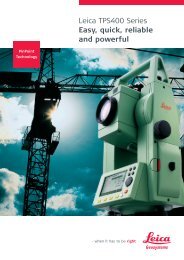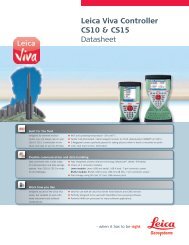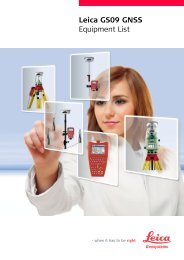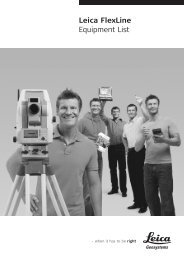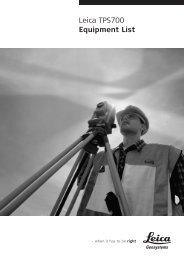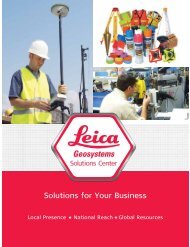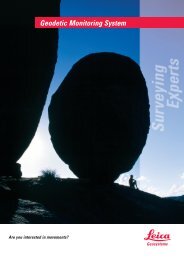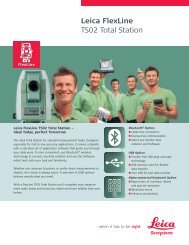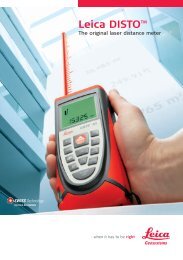2007 apls annual conference - Leica Geosystems
2007 apls annual conference - Leica Geosystems
2007 apls annual conference - Leica Geosystems
- No tags were found...
You also want an ePaper? Increase the reach of your titles
YUMPU automatically turns print PDFs into web optimized ePapers that Google loves.
11:00 AM-12:30 PM12:30 PM - 2:00 PMThursday March 22, <strong>2007</strong>8:00 AM - 3:30 PM - REGISTRATIONSCORPIO ROOM GEMINI I ROOM GEMINI II ROOM PISCES ROOMLUNCHEARLY REGISTRANTS ONLYQUALIFICATION BASEDSELECTION FOR GOVERN-MENT SURVEY CONTRACTSBob JacksonLUNCHEARLY REGISTRANTS ONLYTITLE PROBLEMSCAUSED BY LEGALDESCRIPTIONSJim DorseyLUNCHEARLY REGISTRANTS ONLYHIGHWAY LAW INARIZONARon PlattLUNCHEARLY REGISTRANTS ONLY"FUNDAMENTALSof GIS"by Rudy Stricklan2:00 PM - 2:15 PM BREAK BREAK BREAK BREAK2:30 PM - 4:00 PMQUALIFICATION BASEDSELECTION FOR GOVERN-MENT SURVEY CONTRACTSBob JacksonTITLE PROBLEMSCAUSED BY LEGALDESCRIPTIONSJim DorseyFriday March 23, <strong>2007</strong>8:00 AM - 3:30 PM - REGISTRATIONCERTIFIED FEDERALSURVEYOR PROGRAMDennis MoulandRon Schlerer"GEODATABASEDESIGN"by Rudy StricklanSCORPIO ROOM GEMINI I ROOM GEMINI II ROOM PISCES ROOM6:30 AM - 7:30 AM BREAKFAST BREAKFAST BREAKFAST BREAKFAST7:30 AM - 9:00 AMLIABILITY ISSUES, ALTA,and LOCAL CORNERSJerry BroadusPINS CUSHIONS ANDTHE LAWJohn StockRAILROAD RIGHTS OFWAY Jim DorseyGROUND TRUTH: LOW DISTOR-TION MAP PROJECTIONS FORSURVEYORS AND GIS"by Michael Dennis9:00 AM - 9:15 AM BREAK BREAK BREAK BREAK9:30 AM-11:00 AM<strong>2007</strong> APLS ANNUAL CONFERENCEAQUARIUS HOTEL - LAUGHLIN, NVLIABILITY ISSUES, ALTA,and LOCAL CORNERSJerry BroadusPINS CUSHIONS ANDTHE LAWJohn StockRAILROAD RIGHTS OFWAY Jim DorseyGROUND TRUTH: LOW DISTOR-TION MAP PROJECTIONS FORSURVEYORS AND GIS"by Michael Dennis11:00 AM - 1:00 PM AWARDS LUNCH AWARDS LUNCH AWARDS LUNCH AWARDS LUNCH1:00 PM - 2:30 PMLIABILITY ISSUES, ALTA,and LOCAL CORNERSJerry BroadusPINS CUSHIONS ANDTHE LAWJohn StockPROTECTING THE INTEG-RITY OF SURVEY DATAWITHIN GISDennis McKay"AutoCAD and GIS"by Thomas Homan2:00 PM - 2:15 PM BREAK BREAK BREAK BREAK2:30 PM - 4:00 PMLIABILITY ISSUES, ALTA,and LOCAL CORNERSJerry BroadusPINS CUSHIONS ANDTHE LAWJohn StockSaturday March 24, <strong>2007</strong>PROVIDING USEFULSURVEY INFORMATIONTHROUGH GISTECHNOLOGYDennis McKay"AutoCAD and GIS"by Thomas HomanSCORPIO ROOM GEMINI I ROOM GEMINI II ROOM PISCES ROOM6:30 AM - 7:30 AM BREAKFAST BREAKFAST BREAKFAST BREAKFAST7:30 AM - 9:00 AMMOCK TRIALJerry BroadusREVIEWING LEGALDESCRIPTIONSJim DorseyALTA STANDARDS FORFIELD PERSONNELMike FondrenINTRODUCTIONTo ArcGIS9:00 AM - 9:15 AM BREAK BREAK BREAK BREAK9:30 AM-11:00 AMMOCK TRIALJerry BroadusREVIEWING LEGALDESCRIPTIONSJim DorseyALTA STANDARDS FORFIELD PERSONNELMike FondrenPROTECTING THEPUBLIC"by Ron Platt
APLS Annual Conference Speaker’s Bio’sRobert J. (Bob) JacksonBob is the Forest Land Surveyor for thePrescott National Forest, Prescott AZ. He isan RPLS in 4 states with 18 years experienceas a Surveyor with the USDA Forest Service– having worked on 4 different NationalForests in Eastern and in Western states, aswell as 10 years of experience in privateindustry with various Engineering/Surveyingfirms in the West. Bob has worked “bothsides of the fence” on Government SurveyContracts, as a field going contract surveyorand also preparing solicitations, contractorevaluations, and managing contracts for theFederal Government.provides expert consulting for attorneysworking on difficult boundary dispute andliability cases. To this end Geometrix hasprepared material for surveyor negligencecases across the country, provided surveys offorest, urban, waterfront, harbor, and airportboundaries in Washington , and has preparedunique materials including a report to Congressfor the settlement of a Federal boundarydispute.Jerry has taught advanced surveying classesfor the Federal Bureau of Land Management,and has given legal seminars for surveyorsacross the country. He actively presentscontinuing legal education on surveyingtopics for attorneys. He has writtenboundary law articles for the WashingtonState Bar Association, the American BarAssociation, Professional Education Systems,Inc., and P.O.B. Magazine. He is activelyinvolved in his professional society inWashington . He has been co-chairman of itslegal reference manual committee and chairmanof its digital signature committee.as papers on boundaries for the CaliforniaLand Surveyors Association, CaliforniaLand Title Association, the American Societyof Civil Engineers, and the Nevada Associationof Land Surveyors. He is also an“Able Toastmaster”.Jim is a life member and former State Presidentof the California Land Surveyors. Heholds the distinction of being the first LandSurveyor in California's history to be electedPresident of its State Board of Registrationfor Professional Engineers and Land Surveyors.He is also a member of the Nevada Associationof Land Surveyors, has served onthe NSPS Board of Governors, and is a pastChairman of the Western Federation of ProfessionalLand Surveyors. He is named in"Who's Who" in California and World Wide.Jerry Broadus, P.S., EsqJerry is a licensed surveyor in Washingtonand Idaho , and has had his own practiceMichael Fondren, RLSsince 1989. He is also an attorney licensed topractice in Washington , and before the federalcourts. He has a BA degree from theUniversity of Texas and graduated first inhis law school class at the University ofPuget Sound School of Law.James R. Dorsey, PLS, WRSHis company, Geometrix Surveying, Inc.,Jim Dorsey holds Professional Land Surveyorlicenses in California, Arizona andprovides expert consulting for attorneysworking on difficult boundary dispute andNevada, and his experience in boundary andliability cases. To this end Geometrix hastitle matters spans more than 50 years. Heprepared material for surveyor negligencewas formerly with Right-of-Way engineeringfor Cal-Trans and the Department ofcases across the country, provided surveys offorest, urban, waterfront, harbor, and airportWater Resources. He served as Chief Titleboundaries in Washington , and has preparedOfficer for the California State Lands Commissionand was an Assistant Vice Presidentunique materials including a report to Congressfor the settlement of a Federal boundarydispute.(corporate) for SAFECO Title InsuranceCompany, where he established and headedJerry has taught advanced surveying classesthe Title Research Department and was responsiblefor the underwriting of the com-Ron Platt, RLSfor the Federal Bureau of Land Management,and has given legal seminars for surveyorsacross the country. He actively prepanyboundary matters, specializing in wetlandboundary problems. Jim has served assents continuing legal education on surveyingtopics for attorneys. He has writtenSpecial Advisor to both the Arizona andCalifornia Land Title Associations on WetlandBoundaries.boundary law articles for the WashingtonState Bar Association, the American BarUntil his retirement, Jim was the Principal ofAssociation, Professional Education Systems,Inc., and P.O.B. Magazine. He is ac-James Dorsey & Associates, Land andBoundary Consultants, where his work involvedboundary and title problems in mosttively involved in his professional society inWashington . He has been co-chairman of itsof the Western States, including extensivelegal reference manual committee and chairmanof its digital signature committee.litigation and expert witness experience. Heis a retired Deputy County Surveyor andJerry is a licensed surveyor in WashingtonDivision Manager of the Mapping Team forand Idaho , and has had his own practiceDevelopment Services for Clark County,since 1989. He is also an attorney licensed toNevada.practice in Washington , and before the federalcourts. He has a BA degree from theJim authored "Insuring Wetlands" and coauthored"A Study of Title Problems onUniversity of Texas and graduated first inSwamp and Overflowed Lands". His presentationshave included courses at the Univer-his law school class at the University ofPuget Sound School of Law.sity of California at Riverside and the CommunityCollege of Southern Nevada, asHis company, Geometrix Surveying, Inc.,wellMichael Fondren, RLS. is a registered LandSurveyor in Arizona and Nevada. In his 16years of experience as a surveyor Mike asserved as the assistant Mohave County Surveyorand is currently the Survey managerfor Stanley Consultants Inc in Kingman,Arizona. He is the Vice - Chairmen of theArizona Professional Land SurveyorsAssoc., he has served on the Board of Directorsfor APLS 5 years as a Director for theMohave Chapter and was APLS Secretaryfor 3 of those years.He is a 33 year resident of Mohave County,growing up along the Colorado River, he hasseen many changes though the years and ishappy to be a part of those changes now.Ron obtained an Associates Degree in CivilTechnology from the StateUniversity of New York at Canton. He hasworked as a design drafter,inspector, construction manager, projectmanager, City Surveyor for theCity of Tucson, and Maintenance ManagementProgram Manager for the Cityof Tucson. Currently Ron is an InformationTechnology Managerresponsible for Geographic Information Systemsand MMP development atthe City of Tucson Transportation Department.Ron has lectured atworkshops and for groups on topics coveringsurveying, boundary law, andGeographic Information Systems. Ron hasalso authored several articleson surveying/boundary issues and has authoreda book entitled "ArizonaSurveying and Boundary Law", published in1989.
Dennis McKay, RLSDennis is a registered Land Surveyor inArizona and has a Bachelor of Sciencedegree from Oregon Institute of Technology.He has worked for 27 years as a CadastralSurveyor for the BLM, the last 20in Survey automation efforts, includingseveral years managing the ArizonaBLM’s Geographic Coordinate Data Base(GCDB) project.Currently Dennis is the Cadastral SurveyOffice Lead and the GCDB Lead for theArizona State Office. He is also the AutomationCoordinator for BLM CadastralSurveys nationally. His principal activitiesas Automation Coordinator include:• Working with other Federal, Stateand local agencies along with ESRI todesign the next generation of survey software.Helping define and design a national vendor-independentdata standard for publishingparcel graphics on the internet.Dennis J. Mouland, PLSDennis is a registered professional surveyorin Arizona, New Mexico, and Colorado.He has a Bachelor of Arts degree inOrganizational Management, and is currentlyworking on his Masters Degree inAdult Education. He has been in the surveyingprofession since 1972. His experienceis evenly split between the privatesector, including his own surveying firm,and federal government employment.Dennis was an instructor and/or coursemanager for the BLM/Forest Service“Advanced Cadastral School” for 6 years.In addition to having over 185 technicalarticles published in the U.S. and Canada,Dennis writes a regular column for POBMagazine called “Offsets”. He was acontributing author to the textbook “TheSurveying Handbook”, and authored“Ethics for the Professional Surveyor”in 1996, now in it’s second printing.Dennis also co-authored the boundary andland dispute courses at Colorado StateUniversity, used by federal agencies totrain realty specialists.He conducted seminars for the surveying,geographic information and real estateprofessions from 1984 to 2005. Heformed Cadastral Consultants, Inc. in1987 to provide a high quality continuingeducation service for the surveying, mapping,and real estate professions. CadastralConsultants, Inc. also provided consultingservices to surveyors and attorneyson boundary dispute issues throughoutthe United States. The name waschanged to Cadastral Consulting in 2002and sold to Wendy Lathrop in 2004.Dennis is currently the National CadastralTraining Coordinator for BLM in Phoenix,AZ. In addition, Dennis is a parttimeInstructor of Surveying at the Universityof Wyoming.Rudy Strickland, RLSMr. Strickland is a Senior InformationSolutions Consultant with CH2M HILLin Phoenix, Arizona, where he providesintegrated solutions for clients to map,manage, and maintain their landbase andinfrastructure assets through the applicationof GIS technology.Mr. Strickland is a registered Land Surveyorin Arizona, and is an Emeritus ExecutiveBoard Member of the ArizonaGeographic Information Council (AGIC).He is a former Chairman of AGIC’s GeodeticControl Working Group, a previousChairman of the Advisory Committee forInteractive Computer Graphics at ArizonaState University, a past President of theArizona Chapter of the National ComputerGraphics Association, a past Presidentof the Geospatial Information &Technology Association (GITA), a previousPresident of the Arizona IntergraphUsers’ Association, and was a CorrespondingMember of the Federal GeographicData Committee’s Cadastral Subcommittee.He presently assists in thecoordination of Congressional staff liaisonactivities related to the ArizonaHeight Modernization initiative.He is associated with several professionalsocieties, including the American Congresson Surveying and Mapping, theGeospatial Information & TechnologyAssociation, and is a Charter Member ofthe Arizona Professional Land Surveyors.Michael L. Dennis, P.E., M.S.C.E.Mr. Dennis is owner of Geodetic Analysis,LLC. His firm provides geodetic consultingservices including coordinate systemdesign, planning and adjustment ofcontrol survey networks, GPS baselineprocessing, spatial data management, surveyand GIS data integration, developmentof field and office procedures forsurveying and mapping, training, andcustom algorithm development. In additionto his consulting work, Mr. Dennis iscurrently pursuing a PhD in geodesy on apart-time basis. His PhD research is coordinatedwith height modernization andsurvey control programs of the NationalGeodetic Survey, the US Geological Survey,and the Western Australian Centrefor Geodesy. He is also involved in developingmodern surveying and mappingstandards in Arizona through his membershipon the Geospatial Committee of theArizona Professional Land SurveyorsAssociation.John Stock, RLSRegistered Land Surveyor and US MineralSurveyor has 39 years of combinedsurvey experience, education and instructionin the technical and legal issues facingthe profession in both the Public Landand Colonial States. He has held licensesin Colorado, New Mexico, Nevada, Arizona,Connecticut and Rhode Island.John has served as an instructor, seminarproducer and Director for the ProfessionalLand Surveyors of Colorado. He hastaught examination specific refreshercourses, in the United States Public LandSurvey System for the Arizona ProfessionalLand Surveyors since 2000. Johnhas also created and presented the veryunique and powerful Decisions Seminar,the Basic Surveyor in Court, and BetterProfits Surveying (in cooperation withMilton Denny). John is one of the fewprivate practicing surveyors invited toinstruct at the USFS/BLM National AdvancedResource Technology Center AdvancedCadastral School.John has served the American Congresson Surveying and Mapping as Directorand NSPS as Area 7 Director, Vice Presidentand President. He is currently thechief surveyor for the Maricopa CountyFlood Control District in Phoenix, Arizona,as well as a Certified FloodplainManager.Thomas HomanGila County Public Works GIS CoordinatorTom has been immersed in GIS forthe past 6 years with the Public WorksDepartment of Gila County after beingtapped from the IT department. His initialwork, that continues today, was to developand maintain centerlines for allmaintained roads within the county forstate and federal reporting. Since then hehas been instrumental in establishing additionalcadastral control within theCounty and assisting other jurisdictions intheir efforts. GISwise, Tom is responsiblefor development, programming and presentationof the County mapping internetpresence as well as advancing the conversionof the County's parcel cadastre frompaper to digital format. He is an activemember of the Geospatial Committeeand an associate member of the CentralChapter. Outside interests include underwaterphotography and old car restoration.
Presentation Descriptions:Title Problems Caused by Legal DescriptionsJim DorseyThe seminar discusses title problems caused by legal descriptions. See what happens when the existing record, parent title, is notprotected. We begin with a discussion of legal descriptions and why they must protect the record title, parent title. Learn the importanceprotecting the parent title within the chain of title. Discover if fraud is present when the legal description does not protect therecord. See the conflicts created within the record whenever proper procedure is not observed.What is Proper Procedure? That DEPENDS.Railroad Rights-of-WayJim DorseyThe seminar discusses the difference between Congressional Grant Railroad rights of way from acquired rights of way and title andsurvey concerns caused by such rights of way. The seminar begins with an explanation of Congressional Grant Railroad Rights ofWay and the effect they have on private title once the parent parcel has been patented by the United States . Discover how the CongressionalGrant Railroad Rights of Way are outside of constructive notice under the recoding laws. Learn about the false boundaryevidence. See why one needs to be very careful on the split of the rails rule.Reviewing Legal DescriptionsJim DorseyThe seminar discusses the relationship of the parent parcel with the parcel to be described, the necessity of protecting the "record",and why control should not differ from the record. The seminar begins with the premise that "One cannot convey an estate greaterthan what he owns." Learn why the Assessor's Parcel Number cannot be used as a legal description for conveyance purposes.We will address how the preamble or caption, and the body of the description need to work together to protect the title, satisfy constructivenotice. Discover the difference between a corner and a monument.“Ground Truth” Low distortion map projections for surveying and GISMichael DennisGPS technology and a desire to directly utilize electronic survey data in GIS are together driving a growing awareness of issuesrelated to georeferencing and map projection distortion. In particular, survey data are often intended to represent conditions “atground”, such that distances based on map coordinates equal “true” distances on the ground. But such low distortion survey coordinatesystems are usually not consistent with those used for GIS, and in many cases are not well defined.This workshop will demonstrate a method for seamlessly including survey data in a GIS, regardless of the coordinate system of theGIS. This includes explanation of map projection distortion, discussion of projection types, detailed instructions on optimal designof Low Distortion Projections (LDPs) for survey data, guidance on defining coordinate systems for data transferability, and theimportant issue of documentation (metadata). The overarching goal is to demonstrate that survey and GIS data can coexist withouteither dataset being degraded, and without resorting to approximate “rubber-sheeting” acts of desperation.Protecting the Integrity of Survey Data within GISDennis MckaySurvey data can be stored entirely within relational databases. Properly designed, a database can accommodate all survey data withoutcompromising its integrity, retaining its units, datums or local projection. Measurements are fed into Least Square Analysis/Adjustment to produce optimal coordinates. Advances in database security can apply to survey data as well.Providing Useful Survey Information through GIS TechnologyDennis MckayLeast Square Analysis can unify survey measurements into a single virtual parcel network. This graphic serves as a single accessto all land records that have been scanned or otherwise entered into computers. This presentation explores the realities and the possibilitiesof a common digital representation of parcel data.Fundamentals of GIS for SurveyorsRudy StricklandFor centuries, surveyors were the primary mapmakers for the world. Within just the last thirty years or so, the focus of spatial informationhas subtly changed from maps per se to the data that creates maps and a variety of other geospatial visualizations. A newtwist to an old craft was born: Geographic Information Systems (GIS). Modern surveyors need to better capitalize on this paradigmshift by understanding GIS technology and how it applies to their workflows and business practices. This presentation stepsthrough GIS fundamentals from a surveyor’s perspective, drawing a comparison to current surveying professional operations andhow they would be implemented from a GIS-centric approach.Geodatabase Design for SurveyorsRudy StricklandWith the proliferation of Geographic Information Systems (GIS) technology in all areas of surveying and mapping, it has becomenecessary to deliver survey data in GIS-compatible format. This presentation focuses on the design of surveying geodatabases—databases that contain survey-related data (spatial and tabular attributes) that can be seamlessly integrated with ESRI GIS geodatabases.Fundamentals of database design will be explained, incorporating spatial data types. A practical example of a surveying geodatabaseusing Microsoft Access will be developed in a workshop session of the presentation.Protecting the PublicRon PlattThe sole reason for professional licensure at the State level is simply to "Protect the Public". Although any professional will striveto protect clients as well as the public, State licensure offers penalties for failures to provide a safe product. The GIS profession isnot a regulated profession. And, as a general rule the GIS professionals already operate to protect the public. As a precursor tolikely registration of GIS professionals in the future this presentation will cover the applicable state laws regulating the technicalprofessions as well as offer examples of GIS products that may actually contribute to not protecting the public.
Pins Cushions and the LawJohn StockNew for 2006, John Stock has developed a very powerful one-day session that will create a buzz wherever it is presented! The subjectmatter is volatile. Duplicate monumentation is the scourge of the modern-day, competent retracement surveyor. It has been withthe profession for over 40 years. Utilizing real-life scenarios and solutions, this presentation includes a powerful introduction to disputeresolution.Qualifications based selection for Government survey contractsBob JacksonMost all levels of government (by law or plain common sense) now use a Quality Based Selection process to identify highly qualifiedfirms from which to procure Professional Survey Services. This workshop is designed to help the Registered Professional successfullycompete for “Architectural and Engineering” type contracts, where low bid is not a selection factor. The course, with realworld examples, can help you and your firm:* Understand the basic concepts of “A&E” (Brooks Act) Contracting.* Know how the Quality Based Selection Process Works.* Find Job Opportunities – and Know if You can Compete.* Prepare an Effective Proposal - and Save Time doing it.* Learn Tricks that Work (and some that don’t) for Successful Submissions.Liability Issues, ALTA Surveys, and Local Corners: An Analysis of Case Law and Surveying ResponsibilitieJerry BroadusLiability Issues and ALTA Surveys: Professional liability is based on a "legal theory" that combines the concepts of negligence, contractlaw, and professional responsibility. This course will begin by defining these concepts in a surveying situation, along with adiscussion of defenses such as privity of contract and statutes of limitations. The class will then discuss the ALTA survey environment,with special emphasis on the surveyor's role in complex real estate transactions and on the role of the title company. We willspend time discussing the modern title insurance industry and its effect on the types of title research surveyors often rely on, as wellas its relation to state surveying standards. We will then cover the most recent ALTA standards in some depth, discussing especiallythe legal traps involving boundary research and encroachment locations. The class will include several real world examples of commonproblems encountered while performing ALTA surveys.Local Corners, Bona Fide Rights, and Evidence of Original Corners in the Public Land States: This class involves a discussion of theevolving interpretations of the BLM Manual rules for evaluating evidence and tracking older surveys. We will explore several recentfederal cases that flesh out the Manual rules for testing found monuments that might, or might not, represent perpetuations of originalPLSS corners. We will discuss taking oral evidence, evaluating bearing trees, the weight of topo calls, and many other issues usingspecific courtroom examples. Finally we will discuss how to handle situations that don't fit the more commonly used rules in theManual, such as how to subdivide sections where there is little reliable evidence of the original survey but loads of more recent activityin the form of surveys and occupation. This portion will include examples, both from common experience and from court cases,of dealing with locally set section and quarter corners, locally set subdivision corners, and the bona fide rights of patentees.Mock TrialJerry BroadusA 3 to 4 hour mock trial, followed by discussion, providing insight into witness preparation, attorney's interrogation techniques,preparation of exhibits, and surveying issues. Several sample cases are available, including a surveyor's negligence case, a boundarydispute using area descriptions, a disputed quarter corner case, and others. This is a good class to end a <strong>conference</strong> or seminar series.This class requires more preparation time than other classes. We can either provide two presenters, who will act out the various parts,or we can provide a text for one "volunteer" from the presenting society to read from as a participant. Some additional stage setup isnecessary. If you are interested in this presentation contact the presenter directly to discuss the logistics and obtain the materials.Certified Federal Surveyor (CFedS) programRon Scherler and Dennis MoulandThe Bureau of Land Management (BLM), Bureau of Indian Affairs (BIA), and Office of the Special Trustee for AmericanIndians have announced a certification program for licensed land surveyors performing boundary surveys in IndianCountry. The Certified Federal Surveyor (CFedS) program is a voluntary program to train and certify licensed land surveyorsto perform the commercial activities of boundary surveying and related services to basic federal surveying standardsas established by BLM. The BIA, Tribes, individual allottees, and other federal agencies will be encouraged to selectsurveyors from the CFedS roster when contracting for boundary surveys or other cadastral services.ALTA Standards for Field PersonnelMike FondrenWho’s looking out for you?An introduction to the standards under which we are required to perform Land Surveying in Arizona.Things a party chief should know so that he or she can be the one who is looking out for the professions interest.AutoCAD and GISThomas HomanLeveraging of resources within an organization is a phrase frequently heard. Survey firms looking to get into the GIS market frequentlysee the price and learning curve of the software from the dominant GIS vendor and decide to pass on projects they are otherwisefully competent to engage. This discussion will delve into the GIS functionality built into Autodesk's software lines thatcomes with the Map, Civil and Land Desktop packages.






